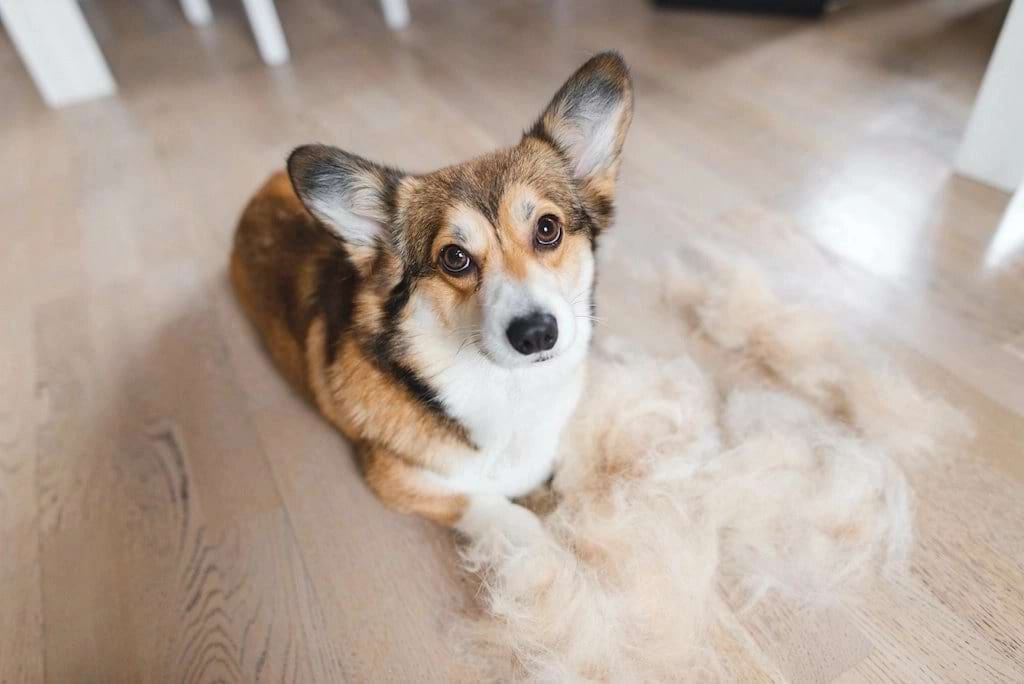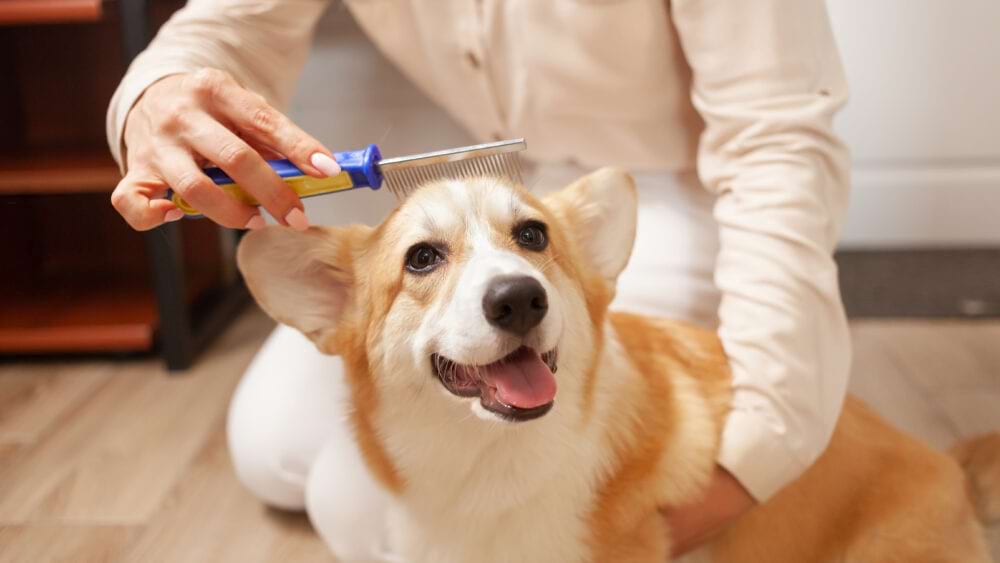Do corgis shed?
Yes, they absolutely do. This seemingly simple question has been a source of much debate and speculation among dog enthusiasts and pet owners alike.
While some claim that these lovable and energetic pups are notorious shedders, others argue that their shedding tendencies are relatively mild and manageable.
In order to separate fact from fiction and gain a deeper understanding of this topic, it is essential to explore the nuances and complexities of corgi shedding behavior.
From genetic predispositions to environmental factors, there are numerous factors that can influence a corgi’s shedding patterns, making this question far more intricate than it may initially appear. So, do corgis shed? The answer, as it turns out, is far from straightforward.
Information about corgi coats

Both Welsh Pembroke and Cardigan Corgis generally sport medium-length coats. However, here’s where it gets intriguing – genetics play a pivotal role. Welsh Pembroke Corgis have a propensity for growing longer hair, a factor that significantly influences their shedding patterns. Shedding is a well-known phenomenon in Corgis, akin to other prolific shedders like Labrador Retrievers. Their double coat, comprising a coarse outer layer and a dense undercoat, ensures a year-round shedding extravaganza.
Now, let’s delve into the world of coat colors. While Cardigan and Welsh Pembroke Corgis flaunt various hues like brindle and blue merle, there’s a fascinating twist – the Welsh Pembroke doesn’t sport blue merle coats.
But here’s the kicker – a Corgi’s coat color can influence how conspicuously their shedding appears, especially on floors and furniture. Therefore, choosing a coat color that harmonizes with your surroundings can work wonders in mitigating shedding’s impact on your household.
In essence, managing a Corgi’s shedding requires a multi-pronged approach, one that takes genetics and the environment into account. While tactics like regular brushing and a wholesome diet can help curtail shedding, tackling this issue necessitates a holistic perspective.
Do corgis shed more during certain times of the year?
The topic of corgi shedding is one that has captured the attention and fascination of dog owners and enthusiasts alike. Indeed, corgis shed daily, but there are two specific periods of the year during which they shed more frequently than at other times.
These are the Summer and Winter months, when corgis undergo a process known as “blowing their coat.” In the Winter, corgis grow a thicker coat to keep them warm, while in the Summer, they shed this extra fur to stay cool.
Managing shedding during these critical times of the year requires a high degree of diligence and attention to grooming for dog. Daily brushing sessions, with a minimum of three times per week, are essential to keeping shedding under control.
A high-quality deshedder tool can also be a useful tool in managing shedding, as can an anti-shedding shampoo. By taking proactive measures to manage shedding during the Summer and Winter months, pet owners can help ensure their corgis stay healthy, happy, and looking their best all year round.
What factors can cause a corgi to shed excessively?

1.Nutritional Inadequacies
Do these little furballs shed? You bet your tail they do! Shedding is a totally natural part of being a corgi, but don’t be fooled – excessive shedding can also be a sign of health issues.
One major cause of excessive shedding in corgis is nutritional inadequacies. That’s right, when a corgi isn’t getting the proper nutrients from their food, their skin and coat can suffer. Omega-3 fatty acids are particularly important for maintaining healthy skin and hair.
But fear not, corgi parents, there are ways to combat excessive shedding caused by poor nutrition. The first step is to talk to your vet about upgrading your corgi’s diet.
You want to choose a high-quality, nutritionally balanced dog food that’s appropriate for your pup’s age and size.
You can also consider adding a supplement like Native Pet’s Omega Oil, which contains two types of fish oil to promote a healthy coat and skin.
2.Allergies
It’s no secret that dogs can react to various allergens in their environment, and corgis are no exception. Pollen, dust, dirt, mold, flea saliva, and even ingredients in their food can trigger allergic reactions in dogs, causing severe itching and scratching.
This can result in heavy shedding, bald patches, and overall discomfort for your beloved pet. If you suspect that allergies are causing your corgi’s shedding, it’s important to seek the advice of a veterinarian.
When it comes to managing allergies in corgis, Native Pet’s Allergy Chicken Chews are an all-natural solution that can help. These chews are specially formulated to build your dog’s natural defense against allergens and target itchy skin, resulting in less shedding and hair loss.
Give your pup relief from allergy symptoms with Native Pet’s effective and safe allergy chews.
3.Parasites
Parasites like fleas, ticks, lice, and mites can be a major factor in excessive shedding among corgis. These pesky creatures can latch onto your pup’s skin and suck their blood, leading to a weakened immune system, hair loss, and even anemia.
To rid your dog of these parasites, you’ll need to take them to a vet for a check-up. The vet can then prescribe a variety of medications to kill the pests and get your corgi’s coat and overall health back to normal.
You can also set your dog up with a pest preventative to avoid future infestations.
4.Stress
Does your corgi seem to be shedding more than usual? One possible culprit is stress. Your furry friend can become anxious due to a variety of reasons such as noise, changes in the environment, and separation anxiety. The result can be increased shedding.
If you think stress may be causing your corgi to shed, it’s a good idea to chat with your vet. In the meantime, you might want to try Native Pet’s Calming Chicken Chews. These tasty treats can help your dog relax, reduce anxiety, and promote better sleep.
By taking care of your corgi’s health and wellbeing, you can help reduce shedding and keep your pet healthy and happy.
5.Hormonal Changes
Corgis going through hormonal changes might experience excessive shedding due to hormonal imbalances caused by spaying, neutering, pregnancy, or going into heat.
These imbalances can resolve on their own, but if you’re worried, consult your vet. Your furry friend’s hormonal changes could indicate a more severe gland issue like Cushing’s disease, so it’s essential to rule out any health concerns.
Don’t fret! With proper care, your pup will be back to their normal shedding routine in no time.
The ultimate guide to grooming your corgi and minimizing shedding
Properly grooming your corgi can be a daunting task for any pet owner. Shedding can become a real issue, but there are a few things you can do to reduce the amount of hair your furry friend leaves behind.
Grooming your corgi weekly, or even daily during shedding season, can make a big difference in keeping your home free of loose hair. However, using the wrong grooming tools can cause more harm than good.
Avoid abrasive products like furminators or undercoat rakes, as these can cut and damage the coat. Instead, stick to a simple metal comb and/or pin brush to keep your corgi’s coat looking healthy and shiny.
When your corgi is blowing coat, it helps to use a high-velocity dog dryer after bathing. This can help remove excess hair and prevent it from sticking to your furniture and clothing.
Line Brushing A Corgi
Line brushing, or line combing, is the most effective method for grooming loose hair out of a double coat. To do this, start at the bottom of your corgi, closest to their feet, and work your way up.
Lift the hair up with your non-grooming hand and comb the hair in a downward motion, making a line with the hair.
Your goal is to see a clearly defined line where the hair meets the skin. It’s best to brush in sections no bigger than the size of your index finger, about 4 to 5 inches.
By following these simple grooming tips, you can keep your corgi’s coat healthy, shiny, and reduce the amount of hair they shed. Remember, a well-groomed corgi is a happy corgi!
Tips and tricks for managing your corgi’s shedding
When it comes to managing your Corgi’s shedding, there are a multitude of factors to consider. First and foremost, it’s important to understand that shedding is a natural and unavoidable aspect of owning a Corgi.
However, with proper care and attention, shedding can be managed to minimize its impact on your home and lifestyle.

1.Brushing
Get ready for some serious hair action because corgis shed a lot! Brushing is your first line of defense when it comes to keeping your home and clothes free of Corgi hair.
You’ll need to brush your furry friend at least three times a week, but during the heavier shedding months, you’ll want to bump that up to daily brushing.
You can use either a bristle brush or a pin style brush, but you have to find the right one for your doggo. Trust us, brushing consistently is the single most important thing you can do to reduce excess dog hair.
If you slack off on the brushing, you’ll be dealing with hair everywhere.
2.Shampoos
Corgi Shampoos: A Guide to Keeping Your Pup Clean
While Corgis are generally hardy and don’t often have sensitive skin, it’s still important to use a natural dog shampoo to avoid any irritants. If your Corgi sheds a lot, consider using an anti-shed shampoo.
But be sure to follow the manufacturer’s guidelines, as over-bathing can cause skin irritation and even more shedding. Bathing your Corgi once a month should be enough, but keep an eye on their skin to make sure it stays healthy.
3.Diet
Corgi nutrition is often an area that many pet owners tend to overlook, but it’s actually quite essential to their overall health and well-being.
To ensure that your Corgi has a healthy coat, it’s important to provide them with a nutrient-dense dog food that is high in Omega fatty acids.
While it might be tempting to cut corners on the food budget, investing in high-quality dry kibble is the best way to keep your furry friend healthy and happy.
Not only will a nutritious diet help keep your Corgi’s coat shiny and soft, but it will also make grooming and brushing sessions much easier in the long run.
By prioritizing your Corgi’s nutrition, you’ll be able to reduce shedding and keep their coat looking and feeling its best. So, while it may be tempting to save money in other areas, investing in high-quality dog food is a must for any responsible pet owner.
4.Supplements
Adding supplements to your Corgi’s diet can help with their coat health. Chewable supplements are especially great and can even be used as a training reward! If your Corgi is picky, you can always go for a liquid supplement that can be added to their food.
Supplements are convenient and can serve multiple purposes, but don’t forget that high-quality dog food should always come first. If you have to choose between buying supplements and investing in your dog’s overall food quality, always choose the latter.
Your Corgi’s coat and skin health should be your top priority.
Some Posts You Wanna Read More
- Corgi-Blue Heeler Mix
- Corgi-Dalmatian Mix
- Corgi-St. Bernard Mix
- Corgi-French Bulldog Mix
- Corgi-Boxer Mix
- Corgi-Pomeranian Mix
- Corgi-Poodle Mix
- Corgi-Pug Mix
- Corgi-Yorkie Mix
- Fluffy Corgi
- Blue Merle Corgi
- Sable Corgi
Frequently asked questions
1.How long do corgis shed?
The hairy question on every Corgi owner’s mind: how long do Corgis shed? The answer is both perplexing and bursty. You might find that with regular grooming, the fur isn’t too overwhelming to handle for most of the year.
However, brace yourself, dear owner, for Corgis always shed. That’s right, there’s never a time throughout the year where they won’t be shedding. Get ready for a hairy situation, folks!
2.Why Corgis sheds a lot?
Corgis are known to shed a lot due to their double coat, which is a common trait among many dog breeds. In fact, shedding is expected and completely normal.
While they may shed more than some breeds, it’s important to note that they shed less than larger, fluffier breeds with longer coats.
So, if you’re considering getting a corgi, be prepared for some shedding, but know that it’s a small price to pay for the love and companionship they bring to your life.
3.Why Corgis sheds a lot in summer and winter ?
Hey there, let’s talk about the perplexing question that has been in your mind – “Do Corgis shed more in the summer or winter?”. The answer is that typically Corgis shed more in the summer season.
That’s because they are getting rid of the thick coat they added during the winter months to keep themselves warm. It’s important to remember that even though shedding is more in summer, Corgis still shed year-round, so grooming should be a regular practice.
Conclusion
In conclusion, corgis are a wonderful breed of dog that come with a lot of love and affection, but also a fair amount of shedding. Shedding is a natural process for all dogs, including corgis, and can be influenced by many factors such as seasonality, nutrition, and stress. While it’s impossible to eliminate shedding entirely, there are many effective grooming techniques and management strategies that can help reduce shedding and keep your home clean.
By being proactive and consistent with your corgi’s grooming routine, and by addressing any underlying health or nutritional issues, you can minimize shedding and enjoy a happy, healthy life with your furry friend. So, don’t let shedding hold you back from experiencing the joys of owning a corgi!

Pingback: Corgi Pomeranian Mix: 5 Interesting Facts You Should Know - Doggo Bio
Pingback: Corgi Poodle Mix: Surprising Facts You Need to Know - Doggo Bio
Pingback: Corgi Pug Mix 101: Everything You Need to Know - Doggo Bio
Pingback: French Bulldog Corgi Mix: Everything You Need to Know - Doggo Bio
Pingback: Blue Heeler Corgi Mix: Exploring the Fascinating World - Doggo Bio
Pingback: Blue Merle Corgi: Exploring the Fascinating World of Corgis - Doggo Bio
Pingback: Fluffy Corgi Breeds: Understanding this Adorable Dog - Doggo Bio
Pingback: Corgi Yorkie Mix: Everything You Need to Know 2023
Pingback: St. Bernard Corgi Mix: Everything You Need to Know 2023
Pingback: Corgi Dalmatian Mix: The Ultimate Handbook for Owners 2023
Pingback: Sable Corgis 101: Everything You Need to Know 2023